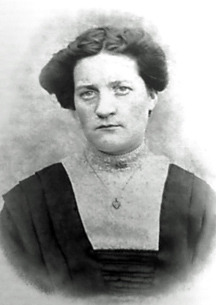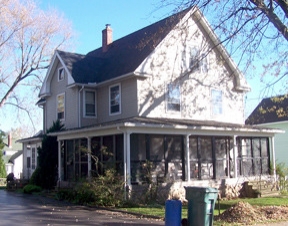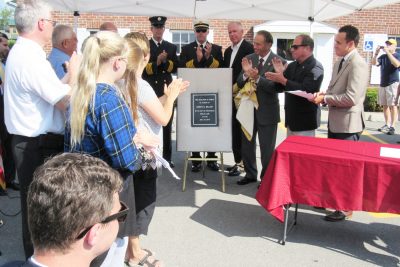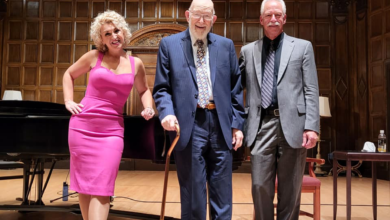May Elizabeth Howard: Hilton’s Titanic Survivor
by David Crumb, Village of Hilton Historian
 May Elizabeth HowardOn April 10, 1912, a little over 100 years ago, May Elizabeth Howard boarded the ship Titanic at Southampton as a third class passenger. Her ticket was A.2. 39186, and had cost her 8 pounds 1 shilling. Her destination was Toronto, Ontario, Canada to join her brother, Ernest, and to find work as a nanny. May’s destiny turned out quite differently.
May Elizabeth HowardOn April 10, 1912, a little over 100 years ago, May Elizabeth Howard boarded the ship Titanic at Southampton as a third class passenger. Her ticket was A.2. 39186, and had cost her 8 pounds 1 shilling. Her destination was Toronto, Ontario, Canada to join her brother, Ernest, and to find work as a nanny. May’s destiny turned out quite differently.
May was born on May 2, 1885 in North Walsham, England. In Walsham she was part of a large family some of whom had emigrated to North America. May made her living as a domestic servant. At the age of 27, after her fiancé had been killed in the Boer War, she decided to leave England and join her relatives in America.
According to Titanic records, May described how the ship rocked with the collision following by a ringing of bells. The doctor came and told them “all was well,” but to get their life belts on. During the voyage, May had become friendly with Mrs. Emily Goldsmith, and when it came time to evacuate the sinking liner she left in “Collapsible C” with her and Mrs. Goldsmith’s son, Frankie. Sadly, Mr. Goldsmith went down with the ship. As May later related, “One of the ships officers grabbed Mrs. Goldsmith and myself and pushed us to the edge of the ship where the lifeboat was being filled with women and children. An officer there shouted, “All men back, women come first.” After her arrival on the Carpathia, she sent the following telegram from New York after disembarking.
“Arrived safe will write later. May”
It had been May’s intention to go to Toronto, but after arriving at her sister, Mrs. Hewitt’s, home in Albion, NY, she changed plans. She needed to recover from post trauma and frozen feet. She later found employment in the home of Sheriff Will Kenyon of Albion helping the family with household duties. Sheriff Kenyon’s brother, the Reverend Randall Kenyon, had just returned home from service in World War I where he had developed a debilitating disease that left him needing special care. Reverend Kenyon was the minister for the First Baptist Church in Hilton, NY, and he and Mrs. Kenyon had five young children. Mrs. Kenyon had great need of assistance at this time and May stepped into the picture and became a valued member of the family for the rest of her life. She helped raised the five Kenyon children, and continued her service to Margaret Kenyon Dieckman and her family until her death in 1958 at age 73.
 The house where May Elizabeth Howard lived in Hilton.Susan Dieckman Harrison remembers May well, and has helped with this research. She remembers that May did not wish to talk about her harrowing experience on the Titanic, and that the Dieckman children respectfully did not ask her questions. What was remembered is that May did not like to go near water, and that she chose to only take sponge baths, and not enter a full tub of water. Also her feet were affected from the freezing water while in the life boat during the five hour rescue. As a result she suffered pain in her feet as she grew older. She was wonderful with children, and spent many an hour playing cards, board games and reading books to them. She often visited other Kenyon children and helped them rear their families. Her life in Hilton was from 1919 to her death on November 28, 1958 a period of 39 years. She is buried in the Kenyon family plot in Boxwood Cemetery in Medina, NY.
The house where May Elizabeth Howard lived in Hilton.Susan Dieckman Harrison remembers May well, and has helped with this research. She remembers that May did not wish to talk about her harrowing experience on the Titanic, and that the Dieckman children respectfully did not ask her questions. What was remembered is that May did not like to go near water, and that she chose to only take sponge baths, and not enter a full tub of water. Also her feet were affected from the freezing water while in the life boat during the five hour rescue. As a result she suffered pain in her feet as she grew older. She was wonderful with children, and spent many an hour playing cards, board games and reading books to them. She often visited other Kenyon children and helped them rear their families. Her life in Hilton was from 1919 to her death on November 28, 1958 a period of 39 years. She is buried in the Kenyon family plot in Boxwood Cemetery in Medina, NY.
On Thursday, May 2, 1912 the Orleans American, Orleans County’s newspaper, published a first-hand account of May’s harrowing rescue experience from the sinking Titanic. This was only a few weeks after the event. May was not yet recovered, still suffering from shock and exposure, but did never the less grant the interview. Her comments fresh from memory take the reader back to the “fateful day.” The following are excerpts from the article.
“I started from Southampton, England to visit my sister in Albion, NY, and owing to the coal strike, was prevented from shipping on one of the smaller ocean liners that left previous to the Titanic.”
“The trip was uneventful until from within our third class cabin we felt the ship graze the edge of the iceberg, and while the shock was not violent enough to throw us over, there was a violent racking of the boat, which was followed by a terrific ringing of the gongs on the boat.”
“I had not undressed for the night and am today wearing the same clothes I wore at the time of the wreck. After going to the deck we were told all was well and to go back to our cabins. About one half hour later we were called out by the ship’s surgeon, who told us to go up on deck and put on life belts. I started with the others, but on my first attempt to gain the deck was thrown down the stairway by the crush of people who were trying to get out that way.”
“Upon arriving on deck, Mrs. Goldsmith, her son and I were pushed into a lifeboat which carried 28 women and children. We had room for 15 more, but the men were reluctant to get in as they did not believe the ship was in that much danger. We all believed that we were taken in small boats while repairs were being made on the ship. The life boat that I left in was the last to leave the ship. Our life boat was rowed by two men. None of the women assisted them during the four or five hours between the time we left the Titanic and the time when the Carpathia rescued us. We saw none of the dead bodies floating around our boat that some passengers are credited with have told about. In our boat, three ladies and one man died of exposure, and were later buried at sea from the Carpathia.”
“Our lifeboat was not more than one half mile from the Titanic when she sank, but seemed much closer. We could hear the band playing, but could not distinguish the piece being played. When the ship sank the lights went out about 10 minutes before she disappeared from view and all we could hear was the cry of those who were drowning. Our boat had left the Titanic about 15 minutes before she sank. After reaching the Carpathia all those who desired it were given small cards, giving the number of passengers and crew that had sailed on the Titanic: the number of members of the crew that were saved and the number drowned. My card which I show you shows the following, 3,182 on board; 600 passengers saved; 110 members of crew and officers saved, 2,470 drowned.”
Mrs. Goldsmith and Frankie moved on to Detroit. Frankie later wrote his memory of the disaster. He in adult life lived near Tiger Stadium in Detroit. When he heard the crowd’s cheer it reminded him of the collective anguished cry of the doomed who went down with the great ship. Frankie was never able to attend games. May, when she would visit her brother in Kuckville, NY on Lake Ontario in the summer, would always sit with her back to the lake.
As an addendum it was noted via the internet that May’s niece, Gladys Whitwood of Walsham Grange passed away in June 2012. Gladys was the daughter of May’s sister, Emily. Gladys assisted Mr. John Balls in his book about the Norfolk survivors, May being one of the 5. May had become a mystery as she had stayed in America. The others had returned home.
This being the 100th year of the Titanic’s sinking it is only fitting to pay tribute to May Howard, a quiet reserved lady who not many people knew, who lived two thirds of her life in Hilton. Today our village can claim one of the Titanic’s 600 survivors as the 100th anniversary is observed.





